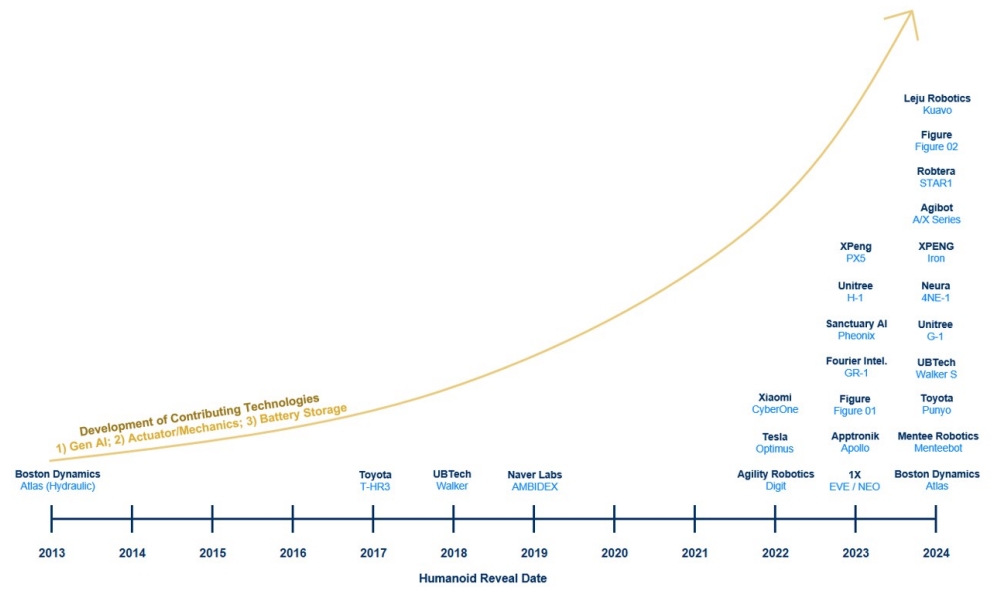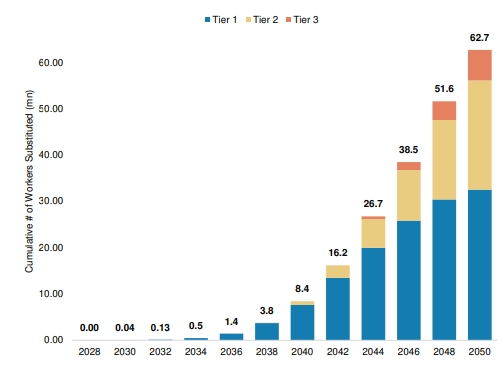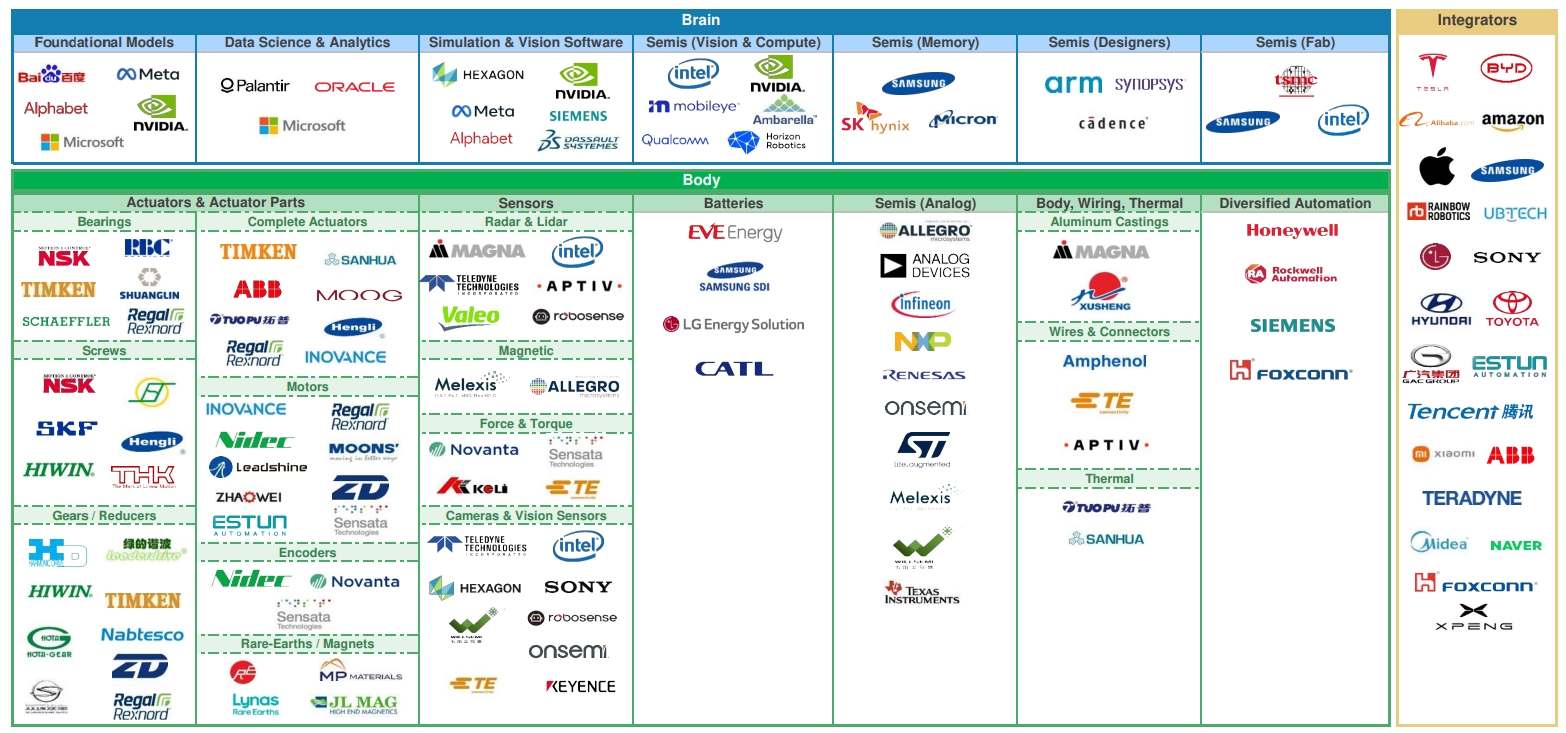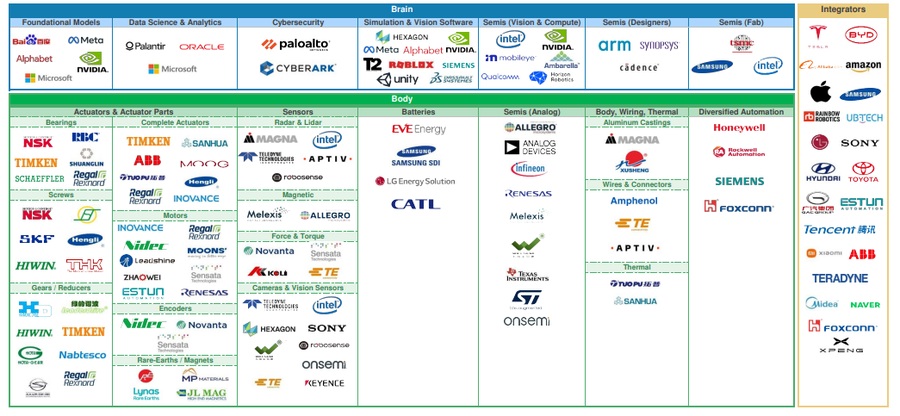Humanoid Robot Market: Development, Prospect, Supply Chain, and Stocks to Watch
TradingKey - Having missed out on NVIDIA in the AI hardware field and failed to keep up with Palantir in the AI software field, those looking to continue riding the AI wave may find humanoid robots—the "best carriers of AI"—to be the next explosive track. Almost everyone is predicting that 2025 will mark the first year of mass production for humanoid robots.
ChatGPT, developed by OpenAI, has demonstrated the strength of artificial intelligence in generative AI and text-based unimodal applications. Meanwhile, humans are also exploring the space of multimodal AI, which integrates sensory inputs like text, images, audio, video, and motion. RobotGPT is considered a key application in this field.
Elon Musk, the world's richest man, is leading the charge with his Optimus robot. Musk has even redefined Tesla, his electric vehicle manufacturer, as an AI and robotics company. During the 2025 Spring Festival Gala for the Year of the Snake, the complex dance performance by robots from Unitree Robotics stunned the world, making the Chinese humanoid robot industry a global focal point, alongside DeepSeek.
It’s not just pure robot manufacturers or supply chain companies making moves; American tech giants like NVIDIA, Microsoft, Google, and Intel are also positioning themselves within the humanoid robot industry. Additionally, automobile companies like Xiaomi, XPeng, NIO, and GAC, as well as mobile phone manufacturers such as Samsung, OPPO, and VIVO, have ventured into this field.
Wang Xingxing, the founder of Unitree Robotics, was invited to a private enterprise symposium where he delivered a speech, signaling China’s national-level focus on humanoid robots. This event marked the renewed interest in humanoid robots at the start of 2025.
In 2023, China's Ministry of Industry and Information Technology stated that humanoid robots are expected to become a "disruptive product" following in the footsteps of computers, smartphones, and new energy vehicles.
So, how can we participate in the development of humanoid robots?
What are Humanoid Robots?
Robots are a common feature in science fiction movies. They assist humans in handling various tasks, and some even possess autonomous consciousness. While traditional robots are widely used in industrial production and other fields, AI-powered humanoid robots are sparking limitless imagination.
According to NVIDIA, a humanoid robot is a general-purpose bipedal robot designed to resemble a human, with the goal of working alongside humans to increase productivity. These robots can learn and perform a range of tasks, such as grasping objects, moving containers, and loading or unloading boxes.
The concept of "AI humanoid robots," also known as "Embodied AI," emerged with the support of large AI models. This concept refers to the comprehensive integration of artificial intelligence and physical entities in the real world.
Unlike traditional robots, humanoid robots are equipped with advanced actuators, sensors, robotic computing systems, and software to help them move and interact, mimicking human flexibility and even self-navigation.
After undergoing rigorous AI training, optimized models and software workflows are deployed onto the robot’s onboard computing system. The combination of effective on-chip computing, AI, actuators, sensors, manipulation, flexibility, and motion strategies grants humanoid robots a high degree of adaptability and allows them to perform a wide variety of tasks.
Humanoid robots offer numerous benefits to humans, including improved human-robot interaction, versatility, adaptability, enhanced productivity, and the ability to handle dangerous tasks. They can be applied in fields such as manufacturing, warehousing and logistics, healthcare, home assistance, and customer service.
The Development of Humanoid Robots
In the 1960s, American scientist Joseph Engelberger proposed the theory of the "Three Laws of Robotics," that is, not to harm humans, not to be harmed by humans, and not to help humans. This theory laid the foundation for the subsequent development of humanoid robot technology.
According to EO Intelligence, since the 1960s, the development of humanoid robots has gone through three stages:
1. The Early Exploration Stage of Intelligence (1960-1999)
In 1972, Waseda University in Japan developed the first bionic human WABO-1, which could grasp and transport objects with its hands through tactile sensors, and its dialogue system also allowed it to communicate with people in Japanese. Subsequently, Honda successively developed the E-series bipedal robots and the P-series humanoid robots.
2. The Initial Stage of Intelligence (2000-2016)
Technological advancements in perception systems and interaction systems enabled robots in this stage to begin to have primary perception functions and be able to conduct limited interactions. At the beginning of this century, Honda launched the humanoid robot P4 or ASIMO. By 2013, ASIMO became the most advanced humanoid walking robot at that time.
3. The Advanced Stage of Intelligence (2016-Present)
Continuous breakthroughs in technologies such as artificial intelligence, machine learning, and computer vision systems have improved the perception and cognitive abilities of humanoid robots, and they have gradually acquired general understanding abilities. The second-generation Atlas robot launched by Boston Dynamics in 2016 has significantly improved in terms of motion flexibility, perception, and decision-making capabilities.
In the past two years, the advent of ChatGPT has pushed the "brain" of robots to a new stage of development. Figure AI, backed by NVIDIA, OpenAI, and Microsoft, has launched the Figure 02 robot, which is known as the "most advanced AI hardware on the earth."

Humanoid Robots Date, Source: Morgan Stanley
With the display of humanoid robots launched by companies such as Unitree Robotics and UBTECH in more diverse application scenarios, the industrial implementation stage of humanoid robots is also underway.
Musk predicts that his Optimus humanoid robot will achieve mass production of thousands of units in 2025, marking the beginning of the "first year of mass production" for humanoid robots; large-scale production and export will begin in 2026, and the long-term demand is expected to reach tens of billions of units.
The Prospect of Humanoid Robots
Markets and Markets predicts that from 2024 to 2029, the global humanoid robot market will experience a compound annual growth rate (CAGR) of over 45%.
Goldman Sachs forecasts that by 2035, the global humanoid robot market will reach $38 billion in size, with a shipment volume of 1.4 million units. Humanoid robots are expected to be used in factories as early as 2024-2027, while the consumer market will likely see adoption between 2028 and 2031.
Citibank predicts that by 2050, the global humanoid robot market will grow to $7 trillion, with the total number of humanoid robots worldwide reaching 648 million units.
According to a Morgan Stanley report, by 2050 the market size for humanoid robots could surpass $5 trillion, with over 1 billion units deployed. Over the coming decades, the human-robot market could reach twice the size of the automotive industry.
Morgan Stanley estimates that by 2040, the U.S. may deploy 8 million worker humanoid robots, impacting $357 billion in wages. By 2050, this number is expected to rise to 77.7 million (previously forecast at 63 million), potentially affecting 75% of jobs, 40% of workers, and approximately $3 trillion in wages.

Cumulative Number of US Jobs with Humanoid Optionality, Source: Morgan Stanley
With the increasing participation of Chinese players, Morgan Stanley predicts that by 2030, the market size for humanoid robots in China will reach 12 billion yuan, with sales of 1.5 million units. By 2035 and 2050, the market size will grow to 216 billion yuan and 6 trillion yuan, respectively, with sales volumes of 7.4 million units and 59 million units.
The Industry Challenges of Humanoid Robots
NVIDIA highlights four major challenges facing the industry: limited training data, design constraints, energy efficiency, and degrees of freedom.
Other studies identify three additional key challenges:
Technical Maturity: High-precision positioning and navigation are limited by environmental interference, map updates, and other factors. Low-latency and real-time control are constrained by hardware and algorithms. Additionally, reinforcement learning and adaptive capabilities are still underdeveloped.
Cost Control: The high precision required for machining and assembly limits production efficiency. The complexity of the products and the diverse personalized needs of users hinder large-scale production.
Application Scenarios: Currently, humanoid robots are concentrated in industrial manufacturing. However, their presence in daily life and service sectors is insufficient, with inadequate market cultivation and relatively high market risk.
The Industry Chain of Humanoid Robots
According to the research report "The Humanoid 100: Mapping the Humanoid Robot Value Chain" released by Morgan Stanley in February 2025, in terms of the structure of humanoid robots, the humanoid robot industry chain includes three parts: brain, body, and integrators, corresponding to semiconductor or key suppliers, industrial component suppliers, and complete machine manufacturing respectively.
■ The Brain: Semiconductor or Software Suppliers
- Semiconductor-Vision: Ambarella(AMBA.US), Horizon Robotics(9660.HK), Qualcomm(QCOM.US), Mobileye(MBLY.US), etc.
- Semiconductor-Computing: Nvidia(NVDA.US), Intel(INTC.US), etc.
- Semiconductor-Storage: Micron Technology(MUS.US), SK Hynix(0660.KS), Samsung Electronics(5930.KS), etc.
- Semiconductor-Design: ARM(ARM.US), Synopsys(SNPS.US), etc.
- Semiconductor-Manufacturing: Taiwan Semiconductor Manufacturing Company (TSM.US), etc.
- Software-Basic Model Category: Google(GOOG.US), Baidu(9888.HK), Meta(META.US), Microsoft(MSFT.US), etc.
- Software-Data Analysis Category: Oracle(ORCL.US), Palantir(PLTR.US), etc.
- Software-Simulated Vision Category: Dassault Systèmes(DSY.PA), Hexagon(HEX.OL), Siemens(SIE.F), etc.
■ The Body: Industrial Component Suppliers
This field involves many companies such as actuators, batteries, sensors, analog semiconductors, and necessary components, such as CATL(300750.SZ), EVE Energy Co., Ltd.(300014.SZ), RoboSense(300014.SZ) in China; Analog Devices, Inc. (ADI.US), Texas Instruments(TXN.US), RBC Bearings(RBC.US), Rockwell Automation(ROK.US) in the United States, etc.
■ The Integrator: Complete Machine Manufacturing
- Start-up Humanoid Robot Companies: UBTECH(9880.HK), Rainbow Robotics(277810.KS), etc.
- Traditional Robot Companies: ABB(ABB.US), KUKA(KUKA.AG), Teradyne(TER.US), etc.
- Automobile Companies: Tesla(TSLA.us), Toyota(TM.US), BYD(1211.HK), XPeng Motors(9868.HK), etc.
- Consumer Electronics Companies: Apple(AAPL.US), LF Electronics(093050.KS), Foxconn(2317.TW), Sony(SONY.US), Xiaomi(1810.HK), etc.
- E-commerce and Internet Companies: Alibaba(9988.HK), Amazon(AMZN.US), Tencent(0700.HK), Naver(035420.KS), etc.

Source: Morgan Stanley
The Morgan Stanley report points out that among the "Humanoid 100" list of humanoid robots, 52% of the companies are publicly involved in the humanoid robot industry chain, and the remaining 48% are also expected to participate eventually. Among the companies that have clearly participated, Asian companies account for 73%, and Chinese companies account for 56%.
The TrendForce report states that from the perspective of humanoid robots, the robot AI ecosystem in the US market is relatively complete, while the Chinese market focuses on establishing a supply chain.
From the perspective of product technical specifications, the products of US manufacturers are mainly characterized by load capacity and endurance according to the application requirements of factories, while Chinese participants focus on diversified deployment and are committed to improving the degrees of freedom of the whole body and hands.
It is worth noting that in the mid-2025 updated Top 100 Humanoid Robot Companies list, Morgan Stanley added game developers (Unity, Roblox, Take-Two) and cybersecurity companies (CyberArk, Palo Alto Networks). The data accumulated by game developers on users' responses to various stimuli, along with their capabilities in creating virtual environments, as well as cybersecurity firms’ expertise in addressing AI-related security needs, are expected to find applications in the development of humanoid robots.
Additionally, this version of the list removed Micron Technology, NXP Semiconductors, SK Hynix, Valeo, and Zhongda Leader, citing reasons such as their relatively limited importance to physical AI or smaller scale compared to other companies.

Source: Morgan Stanley
Recommended Stocks of Humanoid Robots
1. Tesla (TSLA.US)
Investment Highlights:
- Optimus is known as the most advanced humanoid robot to date and Tesla's greatest product ever.
- Musk has repositioned the electric vehicle company as an AI and robotics company.
Tesla has long been involved in the field of humanoid robots. It introduced the Optimus concept in August 2021, unveiled the first working prototype in October 2022, and upgraded its motion coordination in 2023. With the launch of Gen 2 at the end of 2023, Tesla's humanoid robot has become an industry benchmark.
The development of humanoid robots is playing an increasingly significant role in Tesla's stock valuation. Bank of America noted that Tesla's supercomputer computing power will be directed toward the development of Optimus, accelerating robot training. Morgan Stanley believes that the opportunities for humanoid robots are far greater than those for autonomous vehicles, with faster adoption rates.
Morgan Stanley stated that Tesla is a key driver of humanoid robot technology and is at the center of this theme. If Tesla were to replace just 1% of the U.S. workforce with humanoid robots in the future, it could add $100 per share in net present value.
Tesla holds unique advantages in enabling and benefiting from humanoid robots: high-quality, large-scale data derived from driving scenarios; extensive global manufacturing resources; and rich experience in vertically integrating critical hardware and software infrastructure.
2. NVIDIA (NVDA.US)
Investment Highlights:
- Computing Power Support: The absolute leader in AI chips.
- Platform Advantage: High-performance data center AI GPU systems and CUDA ecosystem barriers.
- CEO Jensen Huang: AI and robotics are the two areas with the greatest opportunities across all of NVIDIA's domains, valued in the tens of trillions of dollars.
NVIDIA is not only providing the "brain" for AI but also building a broader ecosystem. The company is accelerating the integration of its AI leadership into humanoid robots. NVIDIA plans to launch the compact Jetson Thor computer, specifically designed for humanoid robots, in the first half of 2026.
NVIDIA boasts a powerful AI software and hardware ecosystem, including the first generative physics-based model development platform, Cosmos; the new Omniverse Blueprint; the robot simulation platform Isaac Sim; and the high-performance Thor chip, which can be applied in the robotics field.
Jensen Huang stated that the next frontier of artificial intelligence is physical AI, and the "ChatGPT moment" for general-purpose humanoid robots is approaching.
At the 2025 Annual Shareholders' Meeting, Huang stated that, in addition to AI as the core driving force, robotics will be the most promising market for NVIDIA. He noted that NVIDIA has long ceased to see itself merely as a chip company, and will continue working toward its vision: powering billions of robots, hundreds of millions of autonomous vehicles, and hundreds of thousands of robotic factories with NVIDIA technology.
In June 2025, NVIDIA entered talks with Foxconn about deploying humanoid robots in the latter's new factory in Houston — marking the first time NVIDIA's products would be manufactured with the assistance of humanoid robots.
3. Amazon (AMZN.US)
Investment Highlights:
- Clear Application Scenarios: A benchmark in global warehouse robot technology.
- The bipedal robot Digit is the first humanoid robot to generate revenue for Amazon and was named Robot of the Year at the "RBR50 Robotics Innovation Awards" in 2024.
Amazon has invested in Agility Robotics, a humanoid robot manufacturer. The Digit developed by Agility Robotics became the first humanoid robot to be officially deployed in the industrial field in 2023. Amazon has also participated in the investment of the prominent humanoid robot company Figure AI.
In June 2025, sources indicated that Amazon is developing humanoid robot software aimed at gradually replacing delivery workers, such as enabling robots to ride in Amazon's Rivian delivery trucks and perform deliveries.
4. Xiaomi Group (1810.HK)
Investment Highlights:
- Powerful Marketing Capabilities: Strong influence of Lei Jun personally.
- Backed by the Xiaomi Ecosystem: Interconnected with multiple product categories.
Xiaomi Group has long been involved in the robotics field. Since investing in Ninebot in 2015, Xiaomi has invested in nearly 50 robot companies over the course of a decade, including Unitree Robotics. In August 2022, Xiaomi unveiled its first full-size bionic robot, CyberOne.
In addition to its investments, Xiaomi has established a dedicated robot division, registered Xiaomi Robotics Technology Co., Ltd., contributed to the establishment of the Beijing Humanoid Robot Innovation Center, and led national key robot research and development projects, demonstrating its strong commitment.
From mobile phones to its broader ecosystem, Xiaomi Group has made breakthroughs across various fields, leveraging its powerful supply chain and marketing capabilities. Compared to many humanoid robot companies, Xiaomi holds a natural advantage in application scenarios.
From the Xiaomi SU7 electric car receiving over 50,000 pre-orders within half an hour, to the Xiaomi YU7 securing more than 200,000 pre-orders in just three minutes, Xiaomi's success in its new automotive industry strategy is evident. Given the similarities between cars and robots in terms of hardware and AI software, as well as the technological expertise Xiaomi has accumulated in the automotive sector, the company's prospects in expanding its robotics business are promising.
5. XPeng Motors (XPEV.US, 9868.HK)
Investment Highlights:
- CEO He Xiaopeng: XPeng is the Chinese automobile company that places the most emphasis on AI and was the first to achieve mass production of large models.
- Complete AI Ecosystem: AI cars, flying cars, AI chips, AIOS operating system, and AI robots.
XPeng launched its humanoid robot, Iron, at the end of 2024. Iron boasts 62 degrees of freedom, utilizes the self-developed Turing AI chip and Tianji AIOS, and has already been deployed in the XPeng Motors factory.
XPeng CEO He Xiaopeng mentioned that while most robots in the industry are currently at the L2 stage, XPeng is confident it will be one of the first Chinese companies to mass-produce L3 robots.
The trend of automobile companies entering the humanoid robot market is growing. As of February 2025, around 18 automobile companies, including NIO, Li Auto, GAC, and SAIC, have announced their entry into the humanoid robot sector.
Securities firms suggest that automotive components and robot components are highly coordinated, and the strategic transformation of automotive and autonomous driving components holds promising potential.
6. Toyota Motor Corporation (TM.US, 7203.JP)
Investment Highlights:
- Partnership with Veteran Robot Company: Teaming up with Boston Dynamics.
- In-depth Research: Toyota Research Institute's focus on large behavior models (LBM).
- Hardware Manufacturing Advantages: Strong industrial resources and talent pool.
In 2024, Toyota Motor Corporation, the world's largest automobile company, announced a partnership with Boston Dynamics, a subsidiary of Hyundai Motor, to develop AI-powered humanoid robots. The combination of Boston Dynamics' robotic dexterity and Toyota's expertise in humanoid behavior technology sets them apart from other robot companies.
Toyota has extensive experience in hardware design, production, and quality control, acquired through its automobile manufacturing process. The company has also built a broad network of suppliers, partnerships, and sales channels across the global automobile industry, with its brand strength widely recognized in the market.



